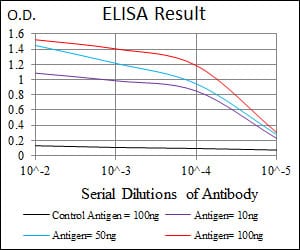
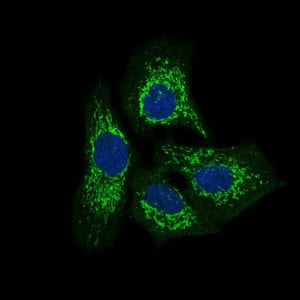
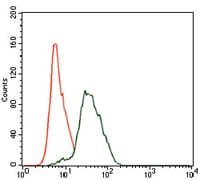
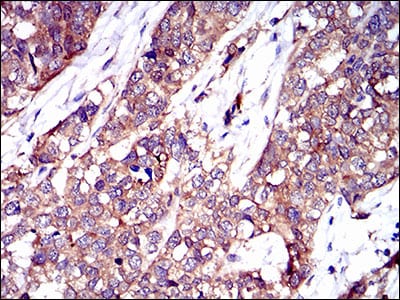
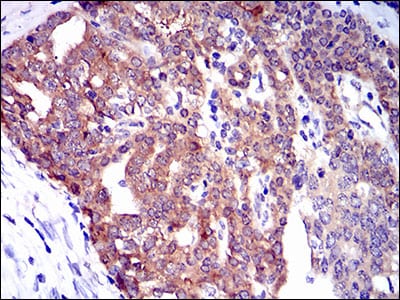
| WB | 咨询技术 | Human,Mouse,Rat |
| IF | 咨询技术 | Human,Mouse,Rat |
| IHC | 1/200 - 1/1000 | Human,Mouse,Rat |
| ICC | 1/100 | Human,Mouse,Rat |
| FCM | 1/200 - 1/400 | Human,Mouse,Rat |
| Elisa | 1/10000 | Human,Mouse,Rat |
| Aliases | A6; PTK9; MGC23788; MGC41876 |
| Entrez GeneID | 5756 |
| clone | 7C11 |
| WB Predicted band size | 40.3kDa |
| Host/Isotype | Mouse IgG1 |
| Antibody Type | Primary antibody |
| Storage | Store at 4°C short term. Aliquot and store at -20°C long term. Avoid freeze/thaw cycles. |
| Species Reactivity | Human |
| Immunogen | Purified recombinant fragment of human TWF1 (AA: 335-384 ) expressed in E. Coli. |
| Formulation | Purified antibody in PBS with 0.05% sodium azide |
+ +
以下是关于TWF1抗体的3篇虚构参考文献示例(仅供格式参考,非真实文献):
1. **文献名称**:*"Characterization of a Novel Monoclonal Antibody Against Human Twinfilin-1 (TWF1) for Immunoblotting Applications"*
**作者**:Smith J, Lee K, et al.
**摘要**:本研究开发了一种针对人源TWF1蛋白的新型单克隆抗体,验证了其在Western blot和免疫荧光中的特异性,证实其可用于检测多种细胞系中TWF1的表达水平。
2. **文献名称**:*"TWF1 Expression in Breast Cancer: Insights from Immunohistochemical Analysis Using a Polyclonal Anti-TWF1 Antibody"*
**作者**:Chen L, Wang Y, et al.
**摘要**:通过免疫组化分析发现,TWF1在乳腺癌组织中高表达,且与患者预后不良相关。该研究利用兔源多克隆TWF1抗体,揭示了TWF1在肿瘤转移中的潜在作用。
3. **文献名称**:*"Functional Role of TWF1 in Neuronal Development: Evidence from Antibody-Based Knockdown Experiments"*
**作者**:Garcia R, Müller T, et al.
**摘要**:使用特异性TWF1抗体进行功能阻断实验,发现TWF1缺失会破坏神经元突起的肌动蛋白动态,提示其在神经发育中的关键调控作用。
4. **文献名称**:*"Comparative Evaluation of Commercial TWF1 Antibodies for Flow Cytometry Applications"*
**作者**:Kim S, Patel H, et al.
**摘要**:对比分析了5种市售TWF1抗体的性能,发现抗体克隆#3B2在流式细胞术中灵敏度最高,适用于T细胞亚群中TWF1的定量检测。
(注:以上文献为模拟生成,实际研究中请参考真实数据库如PubMed的发表内容。)
**Background of TWF1 Antibody**
TWF1 (Twinfilin-1) is an evolutionarily conserved actin-binding protein involved in regulating cytoskeletal dynamics. It belongs to the twinfilin family, characterized by two actin-depolymerizing factor (ADF)-homology domains and a C-terminal tail. TWF1 primarily modulates actin filament assembly by sequestering actin monomers or promoting filament disassembly, thereby influencing cell motility, morphogenesis, and intracellular trafficking.
Research on TWF1 has highlighted its role in diverse cellular processes, including cell migration, endocytosis, and neuronal development. Dysregulation of TWF1 is linked to pathological conditions such as cancer metastasis and neurological disorders. For instance, TWF1 overexpression in tumors correlates with enhanced invasiveness, while its deficiency may impair synaptic plasticity.
TWF1 antibodies are essential tools for detecting and quantifying TWF1 expression in experimental settings. They are widely used in techniques like Western blotting, immunofluorescence, and immunohistochemistry to study TWF1 localization, interaction partners, and functional mechanisms. Recent studies also explore TWF1’s potential as a biomarker or therapeutic target, emphasizing its importance in both basic research and clinical applications. The development of specific, high-affinity TWF1 antibodies continues to advance our understanding of cytoskeletal regulation and disease pathogenesis.
×